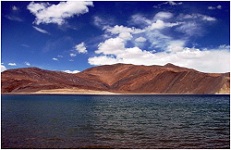
According to P. Sunderarajan writing in The Hindu, work on the world’s largest solar telescope is likely to commence in the Ladakh region of Jammu and Kashmir in India by the end of 2013. The telescope, with an aperture of 2 metres (~6.5 feet), is expected to be of great help in understanding the process of the creation and decay of sunspots, in addition to furthering cutting-edge research on other fundamental processes taking place on the Sun.
The former director of the Bangalore, India-based Indian Institute of Astrophysics and chief investigator of the project, S. Siraj Hasan, said that the telescope could come up either at Hanle or Merak village near Pangong Lake in Ladakh. Once ready, it will be one of the few solar telescope facilities in the world with the capability to do both day and night astronomy. It will also fill the longitude gap between Japan and Europe.
Dr. Hasan was speaking to reporters on the sidelines of a panel discussion organised as part of the on-going centenary session of the Indian Science Congress. The innovative design and backend instruments would further enable observations with an unprecedented high spatial resolution that would provide crucial information on the nature of magnetic fields in the solar atmosphere, he added.
A better understanding of how and why of the formation and decay of sunspots assumes importance as they pose a threat to the communications system on earth as well as satellites orbiting in outer space. Increased sunspot activity frequently accompanies an increase in the outflow of matter from the Sun in the form of solar wind. Charged particles in this wind can interfere with the operation of satellites by introducing what is called background static and also interact with atoms in the upper part of earth’s atmosphere and thus wreaking havoc with the communications systems on the ground.
Satellites in low earth orbit face greater risk during periods of heightened solar activity because the Earth’s upper atmosphere swells up slightly in response to the extra heating, which in turn increases the rate of decay of these satellites.





